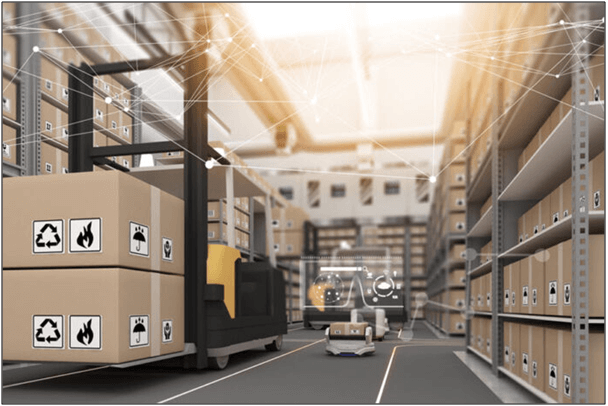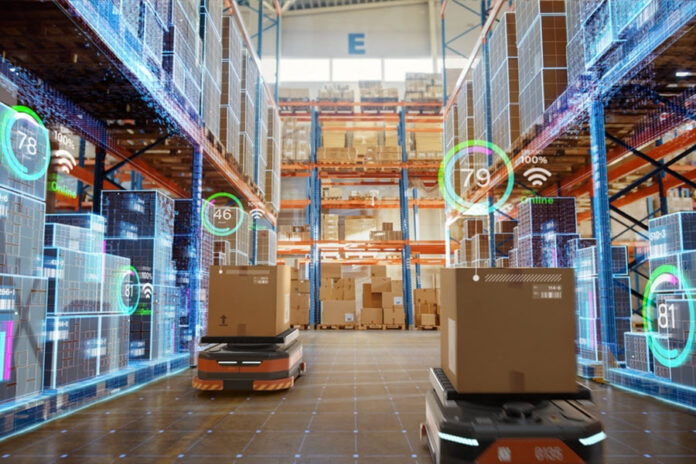Technology applications in warehouses has significantly developed past these years. Various smart items have been developed and are being used for daily operations in today’s fast-paced technological environment. A smart warehouse is a large building used for raw material and other goods storage where computers and machines are used to complete warehouse operations that were previously performed by people. A smart warehouse is purpose-built to maximize effectiveness and efficiency. This is enhanced by incorporating automation, best practices, and possible technologies to ensure that the smart warehouses operate at peak efficiency. The ultimate goal of designing a smart warehouse is to promote efficiency while lowering the cost and time required to perform the processes. This article discusses the application of technology when companies plan to transform their traditional warehouse into a smart warehouse.

Table of Contents
Blockchain Technology
The blockchain is a distributed ledger that stores immutable data shared by members of a blockchain network. The technology is typically used by organizations to record and view transactions at each step of the supply chain. Therefore, distributed ledger technology provides organizations with a single, unvarying source of data for logistics and warehouse planning, management, and dispute resolution. Implementing blockchain technology allows companies to specifically track the location of products in a warehouse during a specific time frame, as well as view user demand in real-time, allowing for more effective management of overall warehouse operations. Smart contracts can be created using blockchain technology, which allows computer programs to execute actions according to pre-defined rules. Using this feature, an organization can simplify transactions between the participating members and provide an audit trail of those transactions. Consequently, supply chain members can be paid more quickly and administrative costs can be reduced. Smart contracts combined with blockchain technology enable organizations to reduce hidden operational costs thus improvising the procedure for better customer service. Smart contracts can be utilized to execute trade deals automatically by connecting importers and exporters, automating the recording of delivery timeframe, and receipt of goods into inventory, and automating payments for received inventories.
Radio Frequency Identification (RFID) Technology
Radio Frequency Identification is a specific type of radio technology that utilizes radio waves to identify tags attached to an object and thus identify the object. RFID tags utilized in inventory management system assists in automating and enhancing inventory management system. The technology is an essential tool for logistical application and is being used to optimize supply chain processes across different industries. The key to technology application is to align the use of the technology with the company mission, for example minimizing warehouse operation cost, optimizing operation processes, and reducing inaccuracy in the inventory system. The technology has continued to improve over the years and the cost of implementation has decreased making RFID a cost-effective and efficient alternative for warehouse process improvement.

Automated Picking Technology
The process of automated warehouse picking involves the use of robotic or semi-robotic technology that assists human warehouse pickers. Using a directed workflow approach, the collaborative robots assist the workforce in quickly moving through all steps in the picking process. By implementing this technology in the warehouse picking process, an organization would be able to decrease the picking time because the collaborative robots able to move across the warehouse floor faster than the human workforce. One of the cost savings would be the rapid implementation that requires zero new infrastructure as it would be a customizable approach to assist warehouses to accommodate seasonal demand.
Automated Guided Vehicle (AGV)
AGVs are used to perform repetitive tasks that would typically be handled by forklifts, conveyor systems, or manual carts that move products. As opposed to other technologies that require re-routing guide wires or other infrastructure to adjust vehicle routes, AGVs provide the flexibility of adjusting routes. AGVs are scalable warehouse process solutions that can add additional units as needed. It is designed to automate tasks for which the human workforce is less utilized, thereby eliminating physically demanding work processes. AGVs navigation type includes magnetic guided tape which has magnetic sensors and follows the layout track using magnetic tape. The wired navigation follows wire paths embedded into the facility floor and the wire transmits signals that AGVs detect via antenna or sensor. The vision guidance required no modification to warehouse infrastructure. The camera records the features along the route and relies on recorded features to navigate. Geo-guidance-guided AGVs recognize objects in surrounding environments to establish a location in real-time to navigate throughout the warehouse.

Big Data Analytics
Traditional methods of data processing can be difficult to handle complex datasets that are managed by big data analytics. Unlike manual processes, big data analytics are capable of identifying or resolving issues faster in an increasingly complex supply chain. In addition to improving supply chain management, big data analytics addresses several strategic, operational, and tactical issues. The analytics technology improvises the decision-making process to reduce costs and improve service levels.
The full content is only visible to SIPMM members
Already a member? Please Login to continue reading.
References
Alan Muralidharan R Pillai, GDLSCM. (2021). Smart Technologies for Integrated Logistics Operations. SIPMM Publications. Available at SIPMM: https://publication.sipmm.edu.sg/smart-technologies-for-integrated-logistics-operations/.(Accessed: 14 June 2022).
Chia Jue Cun Jayce, SDDSC. (2022). Digital Technologies for an Effective Supply Chain. SIPMM Publications. Available at SIPMM: https://publication.sipmm.edu.sg/digital-technologies-an-effective-supply-chain/.(Accessed: 16 June 2022).
Equinox. (2022). 10 Major Pros & Cons of Unmanned Aerial Vehicle (UAV) Drones. Equinox’s Drones Pvt Ltd. Available at https://www.equinoxsdrones.com/blog/10-major-pros-cons-of-unmanned-aerial-vehicle-uav-drones.(Accessed: 16 June 2022).
Roy Dass Samynathan, DLSM. (2021). Technologies for Leveraging Logistics Integration. SIPMM Publications. Available at SIPMM: https://publication.sipmm.edu.sg/technologies-leveraging-logistics-integration/.(Accessed: 15 June 2022).
Soh Chai Xia, DLSM. (2021). Key Technologies for Efficient Logistics Operations. SIPMM Publications. Available at SIPMM: https://publication.sipmm.edu.sg/key-technologies-efficient-logistic-operations/, (Accessed: 15 June 2022).
Sures Appalanaidoo, DLSM. (2021). Smart Technologies for Warehouse Operations. SIPMM Publications. Available at SIPMM: https://publication.sipmm.edu.sg/smart-technologies-warehouse-operations/. (Accessed: 16 June 2022).
Yap Meng Kuan, DLSM. (2020). Application of Technologies for Logistics Integration. SIPMM Publications. Available at SIPMM: https://publication.sipmm.edu.sg/application-of-technologies-for-logistics-integration/. (Accessed: 15 June 2022).

